Tom's Guide Verdict
Google's Nest WiFi mesh networking kit makes a virtue out of being small, while providing enough mesh networking performance for the typical home and an interactive extension speaker. Easy to set up and use, it's the best mesh Wi-Fi system we've seen.
Pros
- +
Good performance
- +
Google Assistant with music
- +
Easy setup
- +
Small and unobtrusive
Cons
- -
Short range
- -
Speaker doesn't get loud enough
- -
Minimal configuration options
Why you can trust Tom's Guide
Google proves that good things really can come in small packages with its Nest WiFi family of mesh routers ($269 for the 2-pack we reviewed). The compact mesh units have the power to fill a home with strong Wi-Fi signal, and even feature a built-in Google Home speaker for voice commands and playing music, giving owners the same sort of smart speaker control offered by the Netgear Orbi Voice, an expensive add-on to our top pick for the previous best mesh Wi-Fi system, the Netgear Orbi.
The Nest WiFi kit isn't perfect – we'd like to see more customization options and better range from the individual units – but compared to the latest competing mesh systems, the Nest WiFi is smaller and more affordable than the Netgear Orbi with Orbi Voice extension, and more powerful than the latest Eero mesh system. In other words, the two-piece kit takes the lead when it comes to delivering Wi-Fi data and music. Read our whole Nest WiFi review to learn why its the best mesh Wi-Fi solution out there. (In fact, we named the Nest WiFi one of the best products of the year in our 2020 Tom's Guide Awards.)
Editor's Note: We periodically update our reviews to make sure that pricing and information is up to date. Our rating and recommendation for the Nest WiFi review is unchanged from when it originally published in August of 2020.
- Google Wifi vs. Nest Wifi: Which mesh router should you buy?
Nest WiFi review: Design
Composed of devices that look like big plastic marshmallows, the Nest WiFi mesh devices are small and easy to hide. In addition to stashing them on a shelf, they fit on a windowsill or on a coffee table. The router has a 4.3-inch diameter and is 3.6 inches tall. By contrast, the Point extensions are a little smaller with a 4.0-inch diameter and 3.4-inch height. Both have shotgun-cooling holes at their bases and are tiny compared to comparable Netgear Orbi devices, which are larger and measure nearly 10 inches tall.
The Nest WiFi devices should fit into a variety of home decors, thanks to Google Home's evolving design language of organic shapes with no hard edges and soft colors. The router is available only in flat white, but the extensions come in Mist (light blue), Sand (tan) or white.
The Nest WiFi concept is similar to Netgear's Orbi Voice: the router is the center of home networking while the Nest WiFi Point Extensions do double duty: They push the Wi-Fi signal farther into the house and can respond to voice commands and play audio. In essence, the extensions are a combination of a mesh extender and a Google Home Mini smart speaker.
Wi-Fi Spec: 802.11ac/dual-band mesh kit with speaker extension
Number of Antennas/Removable: 4/No
Ports: Router — Two Gbps Ethernet, power; Extension — None
Processor: Quad-core 1.4GHz
Memory/Storage: Router —1GB/4GB; Extension — 768MB/512MB
Wi-Fi Chip: Qualcomm QCS 400 family
Size: Router — 4.3-inch (diameter) x 3.6-inch height; Extension — 4.0-inch (diameter) x 3.4-inch height
On its own, the router sells for $169 and can cover 2,200 square feet, according to Google. The router and an extension two-pack, which is enough to fill to 3,800 square feet, costs $269. By comparison, it took three of the older Google WiFi disks to fill roughly that same space. The Nest WiFi three-pack increases the coverage to 5,400 square feet for $349. After that, each additional extension costs $149, a $50 savings compared with the Netgear Orbi Voice speaker extension.
The Nest WiFi is able to accommodate up to 32 extensions, and all but the smallest homes will require an extension or two. The good news is that the previous generation of Google WiFi gear can be used as extensions with Nest WiFi to extend the network's reach but without the audio abilities.
Unlike the triband network topology of Netgear's Orbi systems, the Google Nest WiFi mesh system uses a dual-band approach that does without Orbi's dedicated back channel for moving data between the extension and host router. It does have proactive band steering that sends the data to the least congested channel and the preferred extension. The beamforming tunes the transmitted signal to suit the receiver and can connect with up to 100 clients per device; my two-pack has the potential to link 200 devices.
The Nest WiFi devices should fit into a variety of home decors, thanks to Google Home’s evolving design language.
Each Nest WiFi device has four internal antennas that work with the electronics to create a self-healing 802.11ac network. While the router's 5GHz transmissions uses a 4x4 setup, its 2.4GHz band uses a 2x2 design, creating a maximum throughput of 2,200 Mbps. On the other hand, the 2x2 extensions top out at 1,200Mbps.
They both have Bluetooth and 802.15.4 Thread mesh networking built in to efficiently connect with low-power home-automation devices. On the other hand, the gear lacks the latest WiFi-6 technology.
With minimalist connections, the router has a pair of Ethernet ports, a power plug and a thoughtful cutout to route the cables. The router lacks a USB connector or a power switch, while the extensions do without any wired connection, so they can't be used as cabled access points the way Netgear Orbi hardware can.
Inside, the extension has a microphone array, a 4.8-watt amplifier and a 1.6-inch speaker that radiates the sound 360 degrees. They can hear commands from about 15 feet away, and can be individually used for music or grouped together digitally for a homewide sound system on the cheap.
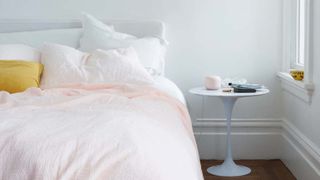
Using Google's Broadcast function, the extensions can be used as an intercom that can also link with other Google Home gear and Nest Hubs for audio calls. There is a switch on each extension to turn the microphone off and preserve privacy.
Surprisingly, based on its size, its sound quality is richer and sharper than Orbi Voice but lacks low-end bass response and doesn’t get nearly as loud as the Orbi RBK40V. It should be fine for a small room, but the music will likely get lost in the chatter of a party. Unfortunately, there's no audio-out jack to patch into an external speaker, but I was able to wirelessly link the extension with a Bluetooth speaker in about 2 minutes. Alternatively, you can pair the extension with a Google Mini speaker as the right or left stereo channel for fuller sound.
The extensions respond to all of the Google Home commands and Google Assistant skills that any Google smart speaker uses and can control everything from the best smart thermostats to smart light bulbs and the best smart plugs. They can be set up with free services, like Google Play Music and YouTube Music, as well as subscription music services; I used my Spotify subscription.
At any time, you can tap the top of the extension to pause or restart the audio track and run your finger over the extension's top to raise or lower the volume. You can also control the volume with voice commands. My favorite is to just say something like "Hey Google, turn it up" or "volume level 4."
Nest WiFi review: Performance
Built around a custom version of Qualcomm's QCS400 family of chips, the Nest WiFi router and extensions use a 1.4GHz quad-core processor and a pair of Digital Signal Processors (DSP), while the extensions have far-field voice-pickup technology. The router has 1GB of RAM as well as 4GB of flash storage for firmware and settings, while the extensions have 768MB of RAM and 512MB of storage space.
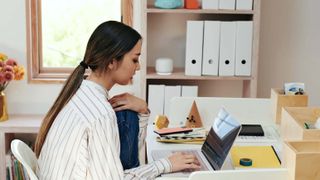
The extensions respond to all of the Google Home commands and Google Assistant skills that any Google smart-speaker uses.
Happily, the router uses a Trusted Platform Module (TPM) to authenticate its automatic firmware updates. This means that the system's software changes are secure and are only accepted if they're digitally signed by Google. The system has WPA 3 (Wi-Fi Protected Access) security built in, but only a handful of networking gear supports this new standard. You can still use the more common WPA 2.
To gauge the performance capabilities of the Nest WiFi gear, we first set it up at the Tom’s Guide open office and tested performance using Ixia's IxChariot. The router’s maximum throughput occurred five feet from the Nest base unit with the ability to move 653.2Mbps. That's a big step up from the original Google WiFi (464.3Mbps) and well ahead of the the 2019 Eero (342.2Mbps). The previous category leader, the Netgear Orbi RBK50 turned in a middling performance of 552.1Mbps at 5 feet.
The Nest WiFi's performance dropped off to 612.0- and 455.1-Mbps at 15- and 50-feet, or between 11- and 15-percent ahead of the Orbi RBK50 mesh system. At 50-feet, the Orbi turned the tables and took the lead with 478.3Mbps versus the Nest’s 455.1Mbps. At 100-feet, the Nest regained the advantage with 394.0Mbps available versus 315.5Mbps for the Orbi RBK50 system.
It blew away the 2019 Eero in our wall penetration testing, where the signal has to travel through three walls and 40-feet of heavy-duty construction. While the Nest delivered 400.6Mbps, the Eero could only muster 84Mbps, less than one-quarter the throughput.
The Nest excelled on our mesh system test with a satellite unit 50-feet from the host router. It was able to transmit 480.1Mbps. By contrast, the Eero managed only 169.1Mbps on the same tests. This is likely the result of its lower performance aspirations. While the Nest WiFi devices are rated to operate at a peak of 2.2Gbps, the new Eero devices top out at 550Mbps, one-quarter the peak abilities of the Nest.
I set the Nest two-pack up in my three-story, 3,500-square-foot home, an older building with thick walls and lots of nooks and crannies. With the router in the basement and the extension a floor above, the two-piece Nest set ran without a problem for more than a week of testing. Because the router lacked the built-in smart speaker, I set up a Nest Hub nearby to provide that same functionality in that room.
The network ran without a problem, reliably distributing my internet connection and playing everything from the latest Kevin Gates track to the sonatas of Domenico Scarlatti to the latest BBC World News headlines. The incoming connection's 235Mbps bandwidth dropped to 187Mbps at the router and 178Mbps at the extension, a 25 % decline.
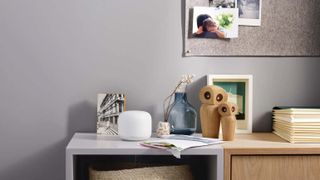
The Nest WiFi not only lets you create a homewide Wi-Fi network, it also has Google Home built in, so it can also listen to your commands and play your favorite tunes.
Overall, the router had a range of 80 feet and the mesh extension added another 50 feet. This should be fine for most homes, but it came up a little short in filling my house, leaving dead spots on the top floor and at the extremities. Clearly, having a second extension would have helped.
The system's throughput was more than enough to pass our informal saturation test, where I connected four different computers, including an Apple Macbook Air, a Microsoft Surface Pro 3, a Samsung Galaxy Note 10+ and a Lenovo Thinkpad T470, to watch videos and listen to Internet radio while moving data back and forth from a networked RAID storage array. I didn't detect any data hiccups or lost frames, even when listening to music on the Nest WiFi extension.
While working, the router stayed cool, but the extension got warm to the touch. The used 3.7 and 4.3 watts of power, respectively, less than half the power an Orbi Router and Voice require. Together, they might cost $8.40 a year in electricity bills if they're connected 24/7 and you pay the national average for electricity of 13 cents per kilowatt-hour. All told, it’s a small price to pay for Wi-Fi and music on demand.
Nest WiFi review: Setup
The installation routine for creating a Nest Wi-Fi network is easy and logical with simple illustrated step-by-step instructions. You will need a phone or tablet because, unlike Netgear's Orbi, there's no way to set it up or configure the Nest WiFi units with a connected web browser. All told, it took a little less than 20 minutes to install the router and extension in my home, a little longer than the 15 minutes it took for an Orbi Voice. For me, it started with installing the Google Home app on my Samsung Galaxy Note 10+ phone.
After tapping "Create a home," I tapped to set up new devices. Then, I gave my house a name.

The software then scanned for and found the Nest WiFi router in a couple seconds. I snapped the QR code found on the underside of the router and allowed the software to connect with the router. A series of animated colored rings appeared around the router's photo on-screen to show it connected.
I then named the router's room and entered what I wanted to use as the network's name and password. At this point I agreed to have Google run networking tests, diagnose problems and create statistics.
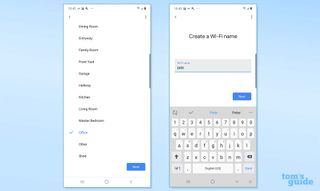

Once the router is set up, you'll need to add the Point extension. I powered it up and the app scanned for and quickly found it. Once I named its room, the extension played a short tune to verify the successful connection.


Next up, I created a voice print to identity me later; it took about a minute of saying various things and waiting on its processing. I then set the system up to play music using Spotify by logging in. I could have linked to my Sirius XM satellite radio account but chose not to.

Nearly done, the Nest WiFi then updated its firmware. Once it checked the connection between the router and the extension, the extension played a short tune. Finished, the app showed all the setup details.

With everything working, I was able to connect my trusty iPad Pro to the extension on the first try. I then took a test drive by asking Google's voice assistant to tell me the time, weather and current traffic on the George Washington Bridge. Finally, I sat back and listened to some tunes.
Nest WiFi review: Configuration
The Nest WiFi equipment relies primarily on the Google Home app for making configuration changes, although the customization options are few and far between. In addition to adding extensions and setting up groups, the app can adjust how bright the router and extensions glow.

At any time, I was able to run a networking test, remotely restart the network or show the Guest network's password on a smart display. The Settings pages for the router and extension show some detail, like IP addresses and firmware version.
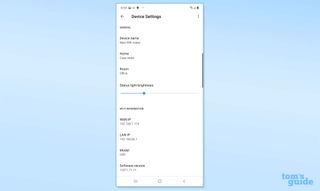
What's missing are traditional setting choices that most other routers have, like setting static IP addresses, managing ports or picking which Wi-Fi channel to use. Most won't miss these items, but it might be a deal-breaker for those who like to tweak their gear.

For accessing these more advanced features, use the older Google Wi-Fi app. There you can make DHCP reservations or manage the system's privacy settings. That the two apps haven't been integrated is a mystery.

Nest WiFi review: Smart-home integration
Along with the Nest WiFi gear, Google's Home app can be a one-stop shop for controlling a variety of home automation items, like any of the best smart light bulbs. To add a device, tap the "+" in the main screen's upper left corner.

Be warned, the Home app is a little picky and balked at using a Belkin Wemo ligh tbulb and an Amazon Smart plug. I was able to use it with Philips Hue lights and C by GE light bulbs; it also works with Sylvania’s LEDVANCE lights. The system allowed me to independently turn the lights on and off as well as dim them via the Home app and the Nest WiFi extension voice commands. The Home app allowed me to pick from the six light colors the GE bulb offered.

The Google Home app includes Family Wi-Fi. It allows the grouping of devices so that the lights and thermostats are part of a different group than the computers. This let me pause the system's Wi-Fi to stop the flow of data long enough for dinner or screen-free family time without affecting other devices that I want to run 24/7.
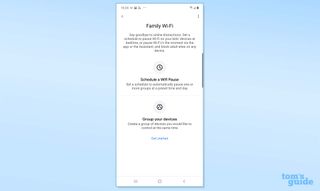
Google backs the Nest WiFi gear with a one-year warranty that includes full support with technicians on call to help 24/7. The Nest support site has several DIY items to help get the gear up and running as well as the ability to call, chat or email them for personal help. By contrast, Netgear provides only 90-days of support.
Nest WiFi review: Verdict
The Nest WiFi takes a big step ahead of the Netgear Orbi with a much smaller size, higher overall performance, and a set up that's simple and straightforward. It also has a Google Home smart speaker built in, giving it a leg up on the Orbi, which requires buying the Orbi Voice to add similar Alexa capability to your home mesh system. Sure, the range isn't as broad as we'd like, and the lack of a web interface means you'll have to set it up using your phone, but it outshines the Netgear Orbi where it counts, giving you faster speeds throughout your home. That's enough to make the Nest WiFi our new pick as the best mesh Wi-Fi system available.
Compared with the Orbi Voice, the Nest WiFi also offers better sound in a compact and more affordable package. The overall volume is a little weak, but the functionality and design make the Nest WiFi the one to get if you want to mix Wi-Fi and a smart speaker.
Brian Nadel is a freelance writer and editor who specializes in technology reporting and reviewing. He works out of the suburban New York City area and has covered topics from nuclear power plants and Wi-Fi routers to cars and tablets. The former editor-in-chief of Mobile Computing and Communications, Nadel is the recipient of the TransPacific Writing Award.


